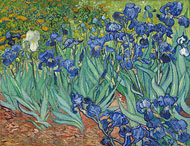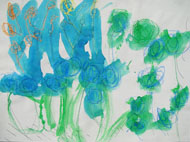Part 1: Warm-Up
1. Remind students about some of the elements of art that they have previously learned about—specifically, colors, shapes, and different types of lines. (For more information about the elements of art, view the web page "Understanding Formal Analysis.") Show students some examples of different colors, shapes, and lines using pictures or by drawing examples on the board or on chart paper.
2. Read the book Camille and the Sunflowers: A Story About Vincent van Gogh by Laurence Anholt. As you read the book, ask students to point out colors, shapes, and types of lines they see. Ask students the following questions:
- Do you see any similarities between the way the illustrators drew the pictures in the book and Van Gogh's work?
- What do you see?
- Why do think the illustrator did this?
Part 2: I Spy Colors, Shapes, and Lines
1. Display a reproduction of the painting Irises by Vincent van Gogh. Tell students that the artist who created the paintings in the book also created Irises.
2. Lead a discussion about Irises, using phrases from the game "I Spy" in order to increase student participation. Encourage students to answer in complete sentences and use descriptive language. Ask students the following questions:
- What do you see? (or, What do you spy?)
- Look at the colors in this work of art. What colors do you see? Show us where you see each color by pointing. (Students can reply, "I spy blue flowers," for example.)
- What shapes do you see in this work of art? Show us where you see each shape by pointing. (Students can reply, "I spy triangles," for example.)
- Do you see any lines in this work of art? What kinds of lines do you see? (Students can reply, "I spy a curvy line.") Where do you see them? Show us where you see each type of line by pointing.
- Have you ever seen any flowers like these before? Where might you see flowers like these?
- Where do you think the painter was when he was painting this work of art? Why do you think that?
Tell students that van Gogh painted Irises outside in a garden.
3. Distribute copies of the Irises Coloring Page handout. As a warm-up, have students trace the shapes and lines that they see on the handout using different colored crayons. Point out the long lines of the stems and the oval shapes on the petals. Guide them in tracing the shapes and lines accurately (with different types of prompts, such as verbal or physical hand-over-hand, as necessary).
4. Distribute plain white paper to students. Have students practice drawing their own flowers. Model how to use different kinds of lines for the stems and different oval shapes for the flowers' petals.
5. Tell students they will be creating their own works of art inspired by flowers, just as van Gogh was inspired to create his Irises. Distribute pictures of flowers or actual flowers to each student. Have them use their fingers to trace in the air the lines and shapes that they see.
6. Pass out white watercolor paper or drawing paper. Have students use crayons to draw flowers inspired by the flowers that you distributed. Encourage them to press down hard with the crayons on the paper. Supervise the students as they create their drawings. Ask the students questions about what colors they are using and why, what shapes they are drawing, and what types of lines they are drawing. Ask them to point to these things in order to check for understanding. Tell the students what you see, using the I Spy phrases (i.e., "I spy a blue circle on your paper" or "I spy a thick green line on your paper").
7. Instruct the students to go to their work areas, having all of their art materials already organized. Ask the students questions about what types of art materials they are going to use (i.e., watercolors, paintbrushes, water). Demonstrate how to mix blue and green watercolors and paint over their piece of art to create a crayon-resist. Supervise them painting a wash over their entire piece of art.
8. Have the students put their artwork in a safe place to dry and supervise and help them clean up their materials.
|
 |
 |
 |
| Irises, Vincent van Gogh, 1889 |
 |
|
 |
Students will be assessed on:
• their participation and effort in the group discussion about color, shape, and line in the warm-up.
• their participation and effort in identifying color, shape, and line in van Gogh's painting Irises.
• the use of color, shape, and line in their own works of art of flowers.
• their ability to follow directions to create a crayon-resist work of art.
• their participation and effort in identifying color, shape, and line in their own works of art.
|
 |
 |
 |
Common Core Standards for English Language Arts
Grades K–2
READING
Literature
K.6 With prompting and support, name the author and illustrator of a story and define the of each in telling the story.
SPEAKING AND LISTENING
K.1 Participate in collaborative conversations with diverse partners about kindergarten topics and text with peers and adults in small and larger groups.
K.4 Describe familiar people places, things, and events, with prompting and support, provide additional detail.
1.3 Ask and answer questions about what a speaker says in order to gather additional information or clarify something that is not understood.
1.4 Describe familiar people places, things, and events, with relative details expressing ideas and feelings more clearly.
2.4 Tell a story or recount an experience with appropriate facts and relevant, descriptive details, speaking audible in coherent sentences.
LANGUAGE
1.6 Use words and phrases acquired through conversations, reading and being read to, and responding to texts, including frequently occurring conjunctions to signal simple relationships (e.g., because).
2.6 Use words and phrases acquired through conversations, reading and being read to, and responding to texts, including using adjectives and adverbs to describe (e.g., When other kids are happy that makes me happy).
Visual Arts Content Standards for California State Public Schools
Kindergarten
1.0 Artistic Expression
1.2 Name art materials (i.e., clay, paint, and crayons) introduced in lessons.
1.3 Identify the elements of art (line, color, shape/form, texture, value, space) in the environment and in works of art, emphasizing line, color, and shape/form.
2.0 Creative Expression
2.6 Use geometric shapes/forms (circle, triangle, square) in a work of art.
4.0 Aesthetic Valuing
4.1 Discuss their own works of art, using appropriate art vocabulary (i.e., color, shape/form, texture).
4.2 Describe what is seen (including both literal and expressive content) in selected works of art.
English–Language Arts Content Standards for California Public Schools
Kindergarten
1.0 Listening and Speaking
1.1 Understand and follow one and two-step oral directions.
1.2 Share information and ideas, speaking audibly in complete, coherent sentences.
2.0 Speaking Applications (Genres and Their Characteristics)
2.1 Describe people, places, things (i.e., size, color, shape), locations, and actions.
|
 |
|
 |




